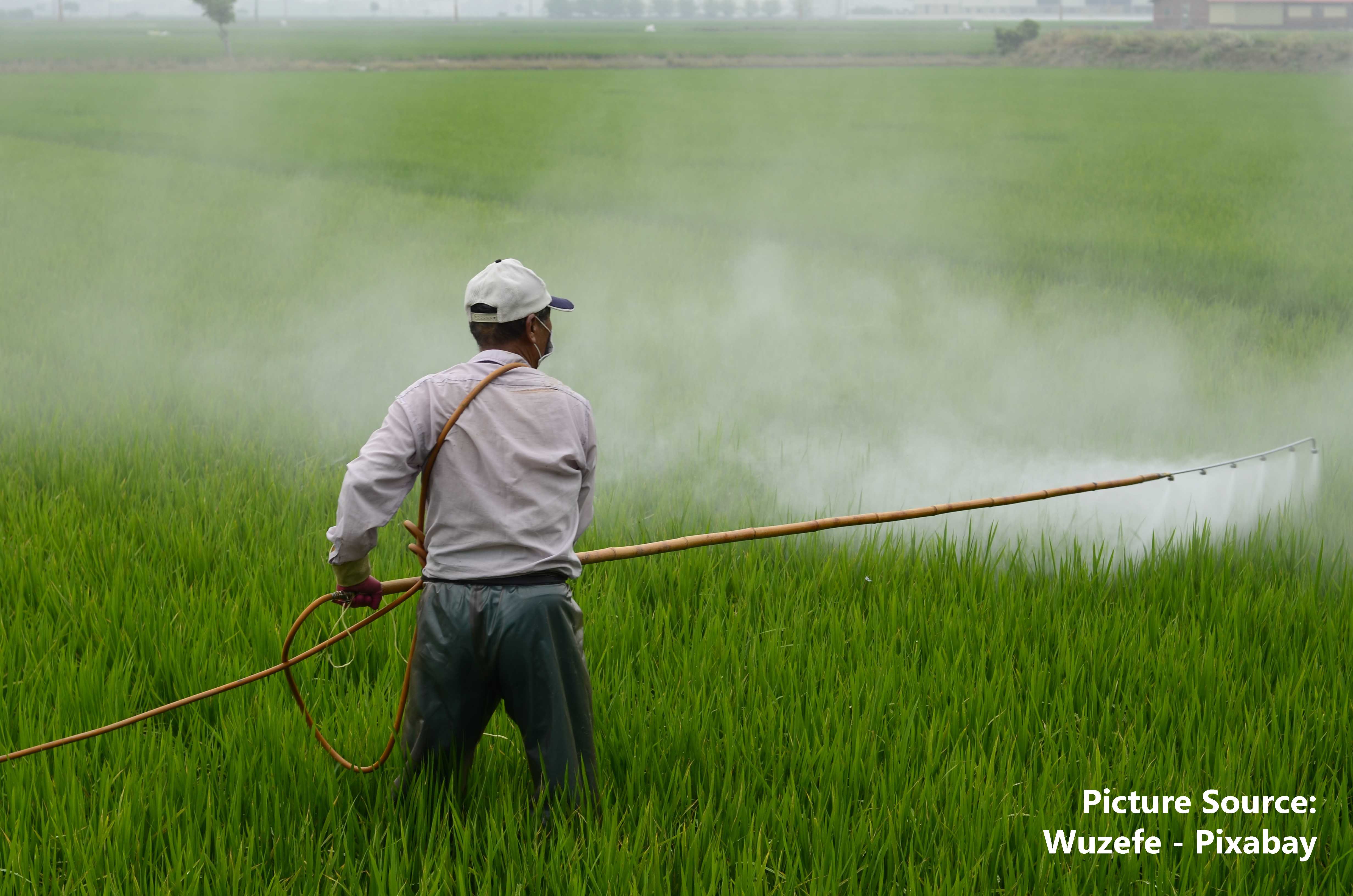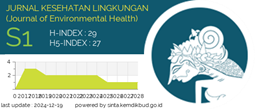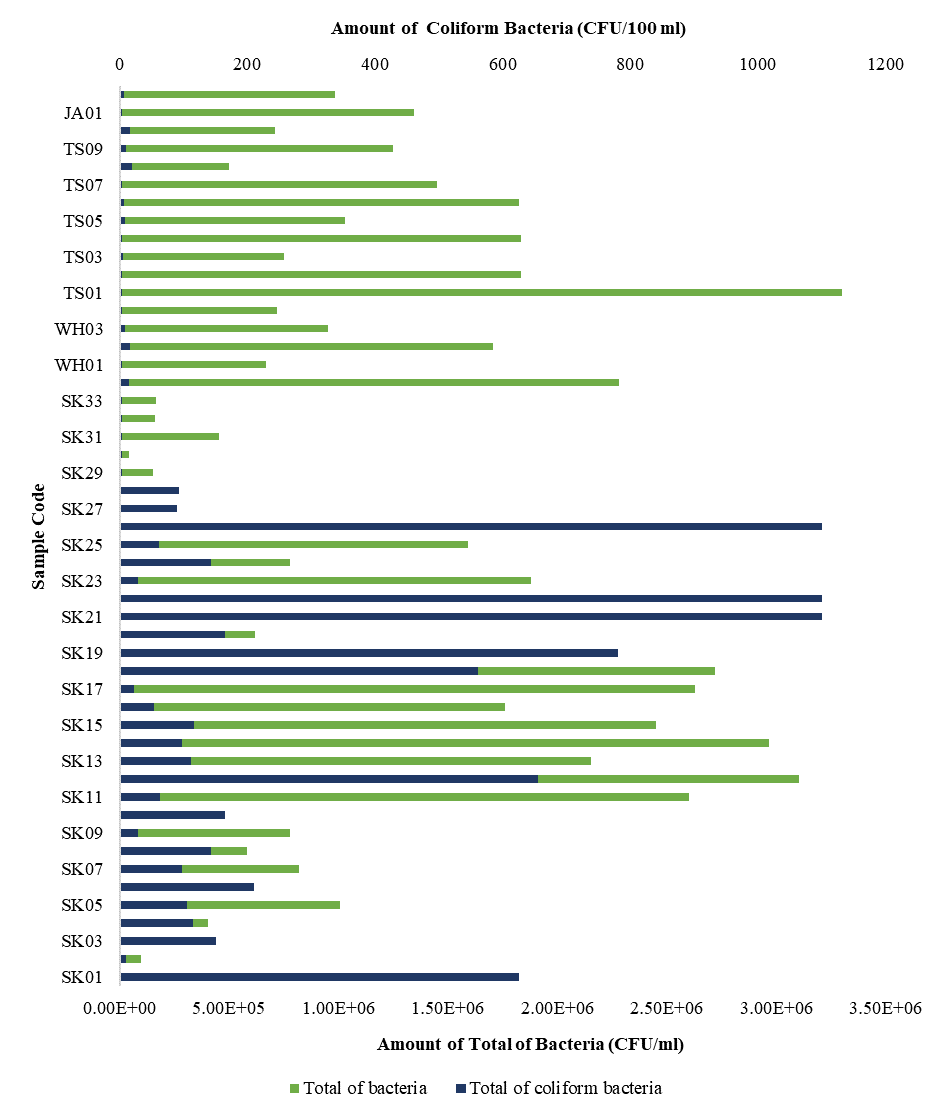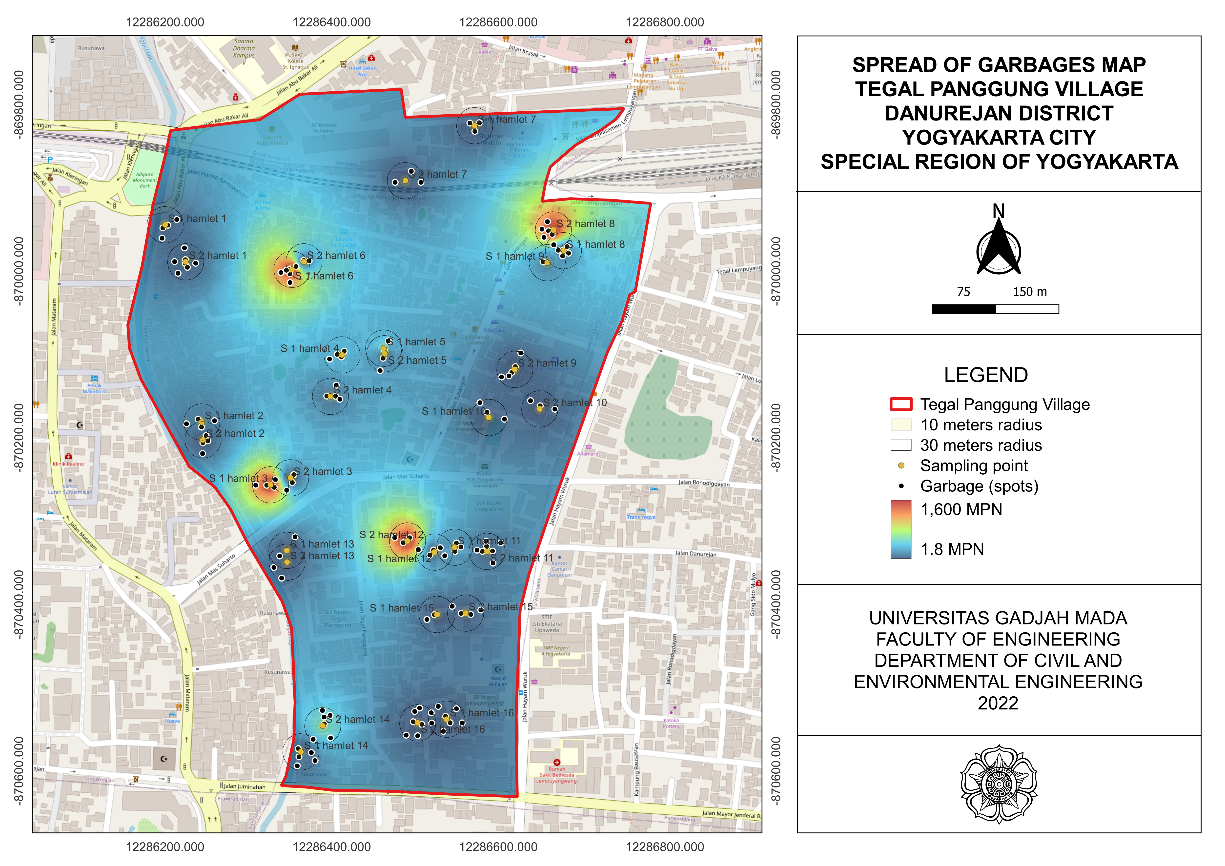ORGANOCHLORINE PESTICIDE RESIDUES ON THE HORTICULTURAL LAND OF THE BANDUNG REGENCY, INDONESIA: ASSESSMENT OF SPATIAL DISTRIBUTION AND HUMAN HEALTH RISKS

Introduction: Agricultural land in the Bandung Regency, particularly horticultural land, is contaminated with organochlorine pollutants. This research aimed to determine the extent of organochlorine contamination, acute and carcinogenic health issues, and their spatial distribution. Methods: The study was undertaken by collecting 163 tillage-layer soil samples. The sampling site was determined using the 1.3 x 1.3 km grid method. Using the QuEChERS method, soil samples were extracted, and the residual amounts of endosulfan, dieldrin, and chlordane were determined using GC-MS. Results and Discussion: Endosulfan, dieldrin, and chlordane residual levels in the soil were determined to be 0.00463, 0.00935, 0.01509, 0.02295, and 0.14432, 0.18602 mg/kg, respectively. Acute health risks for adults and children indicate that unfavorable non-cancerous health outcomes are unlikely. For adults, the overall lifetime cancer risk is 12.27% very low risk, 87.12% low risk, and 0.61% moderate risk. The total lifetime cancer risk for children is 8.59% very low risk, 90.18% low risk, and 1.23% moderate risk. Conclusion: The presence of the three organochlorine residues discovered in agricultural soil samples does not threaten human health, but research is still needed on organochlorine residues as a whole.
Rinardi H, Masruroh NN, Maulany NN, Rochwulaningsih Y. Dampak Revolusi Hijau dan Modernisasi Teknologi Pertanian: Studi Kasus pada Budi Daya Pertanian Bawang Merah di Kabupaten Brebes. Jurnal Sejarah Citra Lekha. 2019;4(2):125–136. https://doi.org/10.14710/jscl.v4i2.21936
Abbassy MA, Khalifa MA, Nassar AM, El-Deen EEN, Salim YM. Analysis of Organochlorine Pesticides Residues in Fish from Edko Lake (North of Egypt) using Eco-Friendly Method and their Health Implications for Humans. Toxicological Research. 2021;37(1):495-503. https://doi.org/10.1007/s43188-020-00085-8
Keswani C, Dilnashin H, Birla H, Roy P, Tyagi RK, Singh D, et al. Global Footprints of Organochlorine Pesticides: a Pan-Global Survey. Environmental Geochemistry and Health. 2022;44(1):149–177. https://doi.org/10.1007/s10653-021-00946-7
Marathe D, Balbudhe S, Kumari K. Persistent Organic Pollutants: a Global Issue, a Global Response. In: Persistent Organic Pollutants. London: CRC Press; 2022. 1−32 p. https://doi.org/10.1201/9781003046806
Wu P, Gu M, Wang Y, Xue J, Wu X. Transfer of Organochlorine Pesticide Residues during Household and Industrial Processing of Ginseng. Journal of Food Quality. 2020;2020(1):1−9. https://doi.org/10.1155/2020/5946078
Oginawati K, Kahfa AN, Susetyo SH. The Effects of the Use of Organochlorine and Organophosphate Pesticides in Agriculture and Households on Water and Sediment Pollution in the Cikeruh River, Indonesia. International Journal of River Basin Management. 2022;1(1):1−7. https://doi.org/10.1080/15715124.2022.2079654
Li Q, Lu Y, Wang P, Wang T, Zhang Y, Suriyanarayanan S, et al. Distribution, Source, and Risk of Organochlorine Pesticides (OCPs) and Polychlorinated Biphenyls (PCBs) in Urban and Rural Soils Around the Yellow and Bohai Seas, China. Environmental Pollution. 2018;239(1):233–241. https://doi.org/10.1016/j.envpol.2018.03.055
Kafaei R, Arfaeinia H, Savari A, Mahmoodi M, Rezaei M, Rayani M, et al. Organochlorine Pesticides Contamination in Agricultural Soils of Southern Iran. Chemosphere. 2020;240(1):1−9. https://doi.org/10.1016/j.chemosphere.2019.124983
Gopalan NK, Chenicherry S. Fate and Distribution of Organochlorine Insecticides (OCIS) in Palakkad Soil, India. Sustainable Environment Research. 2018;28(4):179–185. https://doi.org/10.1016/j.serj.2018.01.007
Al Áfghani MM, Paramita D. Regulatory Challenges in the Phasing-Out of Persistent Organic Pollutants in Indonesia. International Chemical Regulatory and Law Review. 2018;1(1):12–27. https://doi.org/10.21552/icrl/2018/1/5
Haeruddin H, Rahman A, Ayuningrum D. Faktor Biokonsentrasi Pestisida Organoklorin (Aldrin, Dieldrin dan Lindane) dalam Jaringan Lunak Kerang Darah (Anadara granosa Linn.). Indonesian Journal of Fisheries Science and Technology. 2020;16(1):45–50. https://doi.org/10.14710/ijfst.16.1.45-50
Ardiwinata AN. Pemanfaatan Arang Aktif dalam Pengendalian Residu Pestisida di Tanah: Prospek dan Masalahnya. Jurnal Sumberdaya Lahan. 2020;14(1):49−62. https://doi.org/10.21082/jsdl.v14n1.2020.49-62
Cahyaningrum D, Denny HM, Adi MS. Kandungan Pestisida Organoklorin dalam Air Susu Ibu di Daerah Pertanian Bawang Merah Kabupaten Brebes. Jurnal Promosi Kesehatan Indonesia. 2018;13(1):32−45. https://doi.org/10.14710/jpki.13.1.32-45
Diliarosta S. Mengkaji Perilaku Petani Berwawasan Lingkungan. Surabaya: Global Aksara Pers; 2021.
Wahyuni S, Indratin, Poniman, Ardiwinata AN. Identifikasi Cemaran Insektisida Profenofos dari Lahan Bawang Merah di Kabupaten Brebes. Jurnal Litbang Provinsi Jawa Tengah. 2019;17(2):207–215. https://doi.org/10.36762/jurnaljateng.v17i2.800
Acosta-Dacal A, Rial-Berriel C, Díaz-Díaz R, Bernal-Suárez M del M, Luzardo OP. Optimization and Validation of a QuEChERS-based Method for the Simultaneous Environmental Monitoring of 218 Pesticide Residues in Clay Loam Soil. Science of the Total Environment. 2021;753(142015):1−17. https://doi.org/10.1016/j.scitotenv.2020.142015
Isworo S, Oetari PS. The Chemical Compounds from Degradation of Profenofos and Malathion by Indigenous Bacterial Consortium. Journal of Pure and Applied Microbiology. 2021;15(2):897–914. https://doi.org/10.22207/JPAM.15.2.47
Indratin, Wahyuni S, Poniman, Sutriadi MT. Identification of Organochlorine Insecticide Contamination on Shallots Land in Nganjuk Regency, East Java Province, Indonesia. IOP Conference Series: Earth and Environmental Science. 2021;648(1):1−8. https://doi.org/10.1088/1755-1315/648/1/012082
Ding M, Zhao W, Xu X, Tang J, Fan T, Zhang L, et al. Characteristics of Organochlorine Pollution in the Topsoil of the Dawen River Watershed and Potential Risk Assessment in China. Applied Ecology and Environmental Research. 2020;18(1):159–172. http://dx.doi.org/10.15666/aeer/1801_159172
Polanco Rodríguez AG, Araujo León JA, López Cetz R, Long D, Alvarez Cervera FJ, Barache U, et al. Organochlorine Pesticides in the Drinking Water of Merida and its Metropolitan Zone, a Karst Region. Urban Water Journal. 2022;19(1):40-50. https://doi.org/10.1080/1573062X.2021.1955279
Hammam AA, Mohamed WS, Sayed SE-E, Kucher DE, Mohamed ES. Assessment of Soil Contamination Using GIS and Multi-Variate Analysis: A Case Study in El-Minia Governorate, Egypt. Agronomy. 2022;12(5):1−17. https://doi.org/10.3390/agronomy12051197
United States Environmental Protection Agency. Integrated Risk Information System (IRIS). Washington, D.C.: IRIS Chemicals; 2022. https://comptox.epa.gov/dashboard/chemical_lists/IRIS
Ge J, Woodward LA, Li QX, Wang J. Composition, Distribution and Risk Assessment of Organochlorine Pesticides in Soils from the Midway Atoll, North Pacific Ocean. Science of The Total Environment. 2013;452−453(1):421-426. http://dx.doi.org/10.1016/j.scitotenv.2013.03.015
Canadian Ministry of the Environment. Soil, Ground Water and Sediment Standards for Use Under Part XV. 1 of the Ontario Protection Act. Canada: Ministry of the Environment; 2011. 1−32 p. https://dr6j45jk9xcmk.cloudfront.net/documents/998/3-6-3-sediment-standards-en.pdf
Ali SN, Baqar M, Mumtaz M, Ashraf U, Anwar MN, Qadir A, et al. Organochlorine Pesticides in the Surrounding Soils of Pops Destruction Facility: Source Fingerprinting, Human Health, and Ecological Risks Assessment. Environmental Science and Pollution Research International. 2020;27(7):7328–7340. https://doi.org/10.1007/s11356-019-07183-7
Ali U, Riaz R, Sweetman AJ, Jones KC, Li J, Zhang G, et al. Role of Black Carbon in Soil Distribution of Organochlorines in Lesser Himalayan Region of Pakistan. Environmental Pollution. 2018;236(1):971–982. https://doi.org/10.1016/j.envpol.2017.10.083
Thiombane M, Petrik A, Di Bonito M, Albanese S, Zuzolo D, Cicchella D, et al. Status, Sources and Contamination Levels of Organochlorine Pesticide Residues in Urban and Agricultural Areas: a Preliminary Review in Central–Southern Italian Soils. Environmental Science and Pollution Research. 2018;25(26):26361–26382. https://doi.org/10.1007/s11356-018-2688-5
Sruthi SN, Shyleshchandran MS, Mathew SP, Ramasamy E V. Contamination from Organochlorine Pesticides (OCPs) in Agricultural Soils of Kuttanad Agroecosystem in India and Related Potential Health Risk. Environmental Science and Pollution Research. 2017;24(1):969–978. http://dx.doi.org/10.1007/s11356-016-7834-3
Ajiboye TO, Kuvarega AT, Onwudiwe DC. Recent Strategies for Environmental Remediation of Organochlorine Pesticides. Applied Sciences. 2020;10(18):1−24. https://doi.org/10.3390/app10186286
Wahyuni S, Paradifan P, Kurnia A, Indratin I. Pengaruh Pemberian Bacillus Aryabhattai Terhadap Peningkatan Populasi Bakteri Penambat N Simbiotik Dan Peningkatan Produksi Tanaman Bawang Daun. Jurnal Litbang Provinsi Jawa Tengah. 2018;16(2):211–218. https://ejournal.bappeda.jatengprov.go.id/index.php/jurnaljateng/article/view/780
Indratin I, Poniman P, Riyanto S. Teknologi Remediasi Residu Endosulfan di Lahan Bawang Merah. Prosiding Seminar Nasional Kesiapan Sumber Daya Pertanian dan Inovasi Spesifik Lokasi Memasuki Era Industri 4.0. 2020;1(1):53–59. http://repository.pertanian.go.id/handle/123456789/9160
Komarawidjaja W. Industrial Wastewater Containing Heavy Metal Exposureson Paddy Field in Jelegong Village,Rancaekek District, Bandung Regency. Jurnal Teknologi Lingkungan. 2017;18(2):173−181. https://doi.org/10.29122/jtl.v18i2.2047
Fadhilah R, Oginawati K, Romantis NAY. The Pollution Profile of Citarik, Cimande, and Cikijing Rivers in Rancaekek District, West Java, Indonesia. Indonesian Journal of Urban and Environmental Technology. 2018;2(1):14–26. https://doi.org/10.25105/urbanenvirotech.v2i1.3551
Tudi M, Ruan HD, Wang L, Lyu J, Sadler R, Connell D, et al. Agriculture Development, Pesticide Application and its Impact on the Environment. International Journal of Environmental Research and Public Health. 2021;18(3):1−23. https://doi.org/10.3390/ijerph18031112
Utami RR, Geerling GW, Salami IRS, Notodarmojo S, Ragas AMJ. Agricultural Pesticide Use in the Upper Citarum River Basin: Basic Data for Model-Based Risk Management. Journal of Environmental Science and Sustainable Development. 2020;3(2):235–260. https://doi.org/10.7454/jessd.v3i2.1076
Herawati NA, Purnawan T. Effectiveness of Snap Traps on Capturing Rodent and Small Mammals in Rural Area of Two Provinces (Yogyakarta and West Java) in Indonesia. IOP Conference Series: Earth and Environmental Science. 2021;913(1):1−11. https://doi.org/10.1088/1755-1315/913/1/012021
Suhermanto A., Ardianta F., Murtihapsari M., Sofian A. The potential of Barringtonia asiatica Biopesticide from Papua to Eradicate Pests in Aquaculture. Jurnal Airaha. 2022;11(01):157–166. https://doi.org/10.15578/ja.v11i01.335
Qu C, Albanese S, Lima A, Li J, Doherty AL, Qi S, et al. Residues of Hexachlorobenzene and Chlorinated Cyclodiene Pesticides in the Soils of the Campanian Plain, Southern Italy. Environmental Pollution. 2017;231(2):1497–1506. https://doi.org/10.1016/j.envpol.2017.08.100
Ma J, Pan L bo, Yang X yang, Liu X ling, Tao S yang, Zhao L, et al. DDT, DDD, and DDE in Soil of Xiangfen County, China: Residues, Sources, Spatial Distribution, and Health Risks. Chemosphere. 2016;163(1):578–583. http://dx.doi.org/10.1016/j.chemosphere.2016.08.050

This work is licensed under a Creative Commons Attribution-NonCommercial-ShareAlike 4.0 International License.
1. Copyright of all journal manuscripts is held by the Jurnal Kesehatan Lingkungan.2. Formal legal provisions to access digital articles of electronic journal are subject to the provision of the Creative Commons Attribution-ShareAlike license (CC BY-NC-SA), which means that Jurnal Kesehatan Lingkungan is rightful to keep, transfer media/format, manage in the form of databases, maintain, and publish articles.
3. Published manuscripts both printed and electronic are open access for educational, research, and library purposes. Additionally, the editorial board is not responsible for any violations of copyright law.
JKESLING by UNAIR is licensed under a Creative Commons Attribution-ShareAlike 4.0 International License.







































